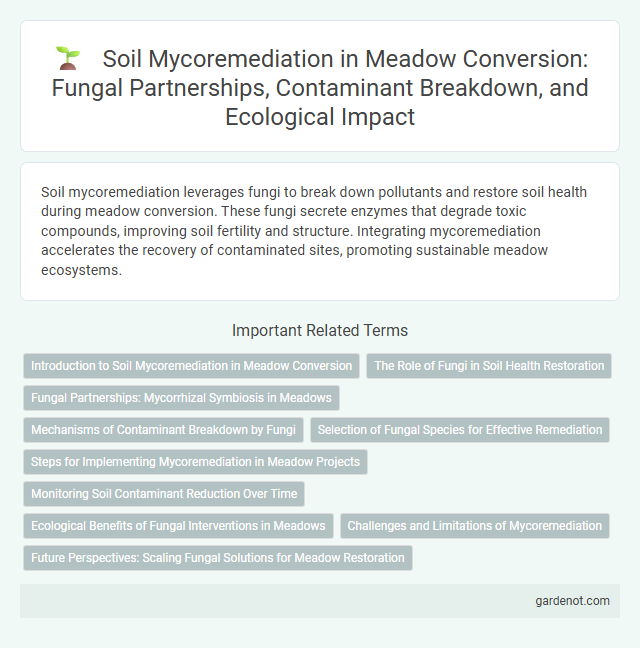Soil mycoremediation leverages fungi to break down pollutants and restore soil health during meadow conversion. These fungi secrete enzymes that degrade toxic compounds, improving soil fertility and structure. Integrating mycoremediation accelerates the recovery of contaminated sites, promoting sustainable meadow ecosystems.
Introduction to Soil Mycoremediation in Meadow Conversion
Soil mycoremediation leverages fungi to detoxify and restore contaminated soils during meadow conversion, enhancing soil health and biodiversity. Fungal networks break down pollutants such as hydrocarbons, heavy metals, and pesticides, facilitating natural soil regeneration. Implementing soil mycoremediation accelerates meadow establishment by improving soil structure and nutrient cycling.
The Role of Fungi in Soil Health Restoration
Fungi play a crucial role in soil mycoremediation by breaking down organic pollutants and enhancing nutrient cycling, which accelerates soil health restoration in meadow conversions. Their extensive mycelial networks improve soil structure, increase water retention, and promote beneficial microbial communities essential for sustainable meadow ecosystems. This biological activity helps detoxify contaminants, revitalizes degraded soils, and supports plant growth in restored meadow environments.
Fungal Partnerships: Mycorrhizal Symbiosis in Meadows
Mycorrhizal symbiosis plays a crucial role in soil mycoremediation within meadow ecosystems by enhancing nutrient uptake and detoxification processes. Fungal partnerships with plant roots facilitate the breakdown of organic pollutants and heavy metals, improving soil health and fertility. These symbiotic relationships increase microbial diversity and accelerate the restoration of contaminated soils in meadow conversions.
Mechanisms of Contaminant Breakdown by Fungi
Fungal mycoremediation leverages enzymatic processes such as lignin peroxidase, manganese peroxidase, and laccase to degrade complex organic contaminants in soil. These extracellular enzymes break down persistent pollutants like polycyclic aromatic hydrocarbons (PAHs) and pesticides into less toxic compounds, enhancing soil health. Mycelial networks facilitate the adsorption and transformation of heavy metals, contributing to comprehensive contaminant removal during meadow conversion.
Selection of Fungal Species for Effective Remediation
Selecting fungal species for soil mycoremediation in meadow conversion involves prioritizing those with high enzymatic activity capable of degrading pollutants like hydrocarbons and heavy metals. Species such as Pleurotus ostreatus and Trametes versicolor demonstrate robust ligninolytic enzyme production, enhancing soil detoxification and nutrient cycling. Targeted use of these fungi accelerates remediation efficiency, restoring soil health and promoting sustainable meadow ecosystems.
Steps for Implementing Mycoremediation in Meadow Projects
Implementing mycoremediation in meadow projects involves selecting appropriate fungal species known for their enzymatic ability to degrade pollutants and facilitate soil detoxification. The process begins with soil assessment to identify contamination types and levels, followed by inoculating the soil with fungal mycelium either through spore application or colonized substrate incorporation. Maintaining optimal moisture, temperature, and pH conditions is essential to promote fungal growth and maximize the breakdown of organic pollutants, leading to restored soil health and enhanced meadow biodiversity.
Monitoring Soil Contaminant Reduction Over Time
Monitoring soil contaminant reduction during meadow conversion involves regular sampling and analysis of mycoremediation activity, focusing on fungal enzyme levels and contaminant concentrations. Molecular techniques like qPCR and chromatography are used to track the degradation of pollutants such as polycyclic aromatic hydrocarbons (PAHs) and heavy metals over time. Data collected enables the assessment of fungal efficiency, ensuring the restoration of soil health and promoting sustainable meadow ecosystems.
Ecological Benefits of Fungal Interventions in Meadows
Fungal interventions in meadow soil enhance mycoremediation by breaking down pollutants, improving nutrient cycling, and restoring soil health. Mycelium networks increase microbial diversity and organic matter content, promoting plant growth and ecosystem resilience. These ecological benefits contribute to sustainable meadow conversion by reducing contaminants and fostering biodiversity.
Challenges and Limitations of Mycoremediation
Mycoremediation faces challenges such as limited fungal species effectiveness against diverse soil contaminants and slow degradation rates in complex soil matrices. Environmental factors like soil pH, moisture, and temperature fluctuations significantly influence fungal growth and pollutant breakdown efficiency. Scaling mycoremediation from laboratory to field applications often encounters inconsistencies due to variable soil conditions and microbial competition.
Future Perspectives: Scaling Fungal Solutions for Meadow Restoration
Scaling fungal solutions for meadow restoration involves enhancing soil mycoremediation techniques to accelerate degradation of contaminants and improve soil health. Future research emphasizes optimizing fungal strains and inoculation methods to increase adaptability and efficacy across diverse meadow ecosystems. Integrating mycoremediation with remote sensing and soil microbiome analysis promises precise monitoring and large-scale application, supporting sustainable meadow ecosystem recovery.
Soil mycoremediation Infographic

 gardenot.com
gardenot.com